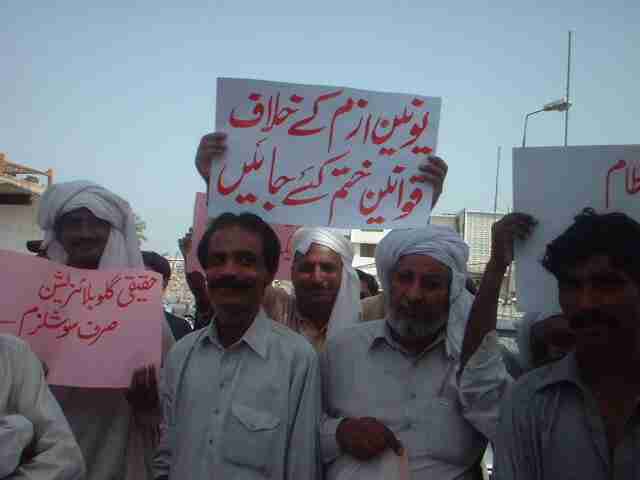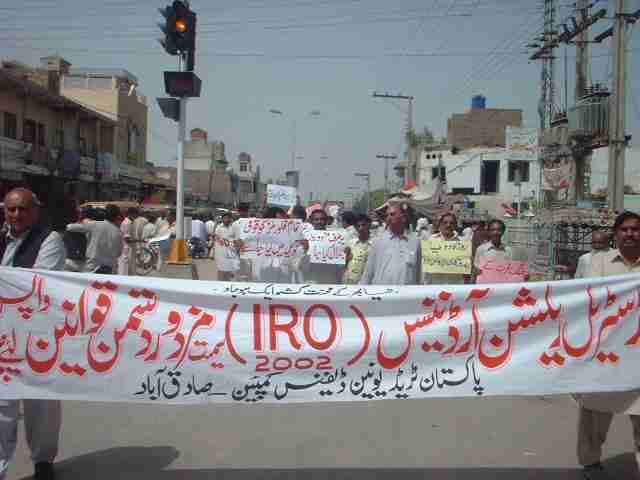The sacking of Prime Minister Zafarullah Jamali by the Military dominated establishment is a set back for the fragile and jittery set-up cobbled together by the state after the 2002 elections. Most people can't comprehend why such a subservient and docile person as Jamali has been sacked. In reality this act reflects a ferocious struggle between different sections of the state and the ruling classes.
In the last few weeks there was a resurgence of violence in different parts of the country. Bomb blasts rocked Karachi and other cities of Pakistan. Rampant sectarian killings took place. A military operation was launched in Wana, the tribal district along the Afghan border, against the remnants of 'Al Qaida' sheltered by the tribal clans at huge rents.
The extensive influx of black money generated through drug trade at the behest of the CIA in the last three decades in Afghan and other operations has been channelled into the coffers of the military top brass and these fundamentalist outfits. It has been widely acknowledged that conflict between different factions of the state has been fuelled by the insistence of the Americans to a greater control over these funds.
As the pressure from this unrest and the unravelling violence mounted, the contradictions within the state became exasperated. The cracks in the army widened when the US reversed its policy to wards these fundamentalists after 9/11. Musharraf has been trying to paper over these fissures but after each brief intermission they open up even more glaringly. This necessitates the sacrifice of scapegoats like Jamali to stave off the crisis. But this is a temporary and short-lived measure. Sooner rather than later the crisis erupts again on the surface albeit with a greater intensity.
The conflict within the state is also reflected within its political offshoot, the Pakistan Muslim League. Two of the candidates to replace Jamali were Ijaz ul Haq, the son of the former brutal dictator General Zia ul Haq, and Humanyun Akhtar, son of General Akhtar Abdul Rehman, the ISI chief under Zia and the executioner of the Afghan reactionary insurgency of the 1980s. Both these generals were killed in a plane crash in 1988, after they had tried to stray too far from the American policy on Afghanistan. However, they had accumulated huge sums of money and their sons are now billionaires. They were said to be the candidates of the so-called hard line nationalist/fundamentalist faction of the Army.
After the rumours that lasted for 37 days the more pro-American faction seems to have prevailed. Shujaat Hussain, the leader of the Muslim League and physically disabled rightwing feudal landlord, has been nominated as interim prime minister. Shaukat Aziz, the World Bank's whiz kid who is the present finance minister, will replace him. He is a former employ of Citicorp and has close connections with the IMF.
His recent budget speaks volumes about his pro-market policies and his deep belief in so-called "trickle down" economics. Under Musharraf he has pursued the IMF dictates with ruthless savagery for five years. The pattern seems to be similar to what has been done in India when Manmohan Singh replaced Sonia Ghandi as prime minister under the pressure of finance capital to ensure the continuity of the drastic market reforms. It also shows the sinking confidence of the imperialist institutions that now want to get the slot of prime ministership rather that the previous finance ministry for their witch doctors.
The pursuance of these policies has been a disaster for the masses in Pakistan. Under the shining coat of fantastic macroeconomic figures, poverty, misery and disease have risen sharply. In these five years the population living below the absolute poverty line has risen from 32% to over 44%. Everyday 10,000 more people fall below the poverty line in Pakistan. About three fourths of the population is surviving on less than two dollars a day.
In the name of creating a better and conducive atmosphere for foreign investments the most vicious attacks have been launched against the workers. The policies of downsizing, privatisation, restructuring, liberalisation and others are directly devastating the lives of millions. The claim that they will generate one million jobs in the year 2004-05 is a farce. It is a deceit and falsity from beginning to end. These policies under the guiding hand of the imperialist institutions have only destroyed jobs, wrecked industry and slashed the already low living standards of the masses. The whole concept of developing the economy and poverty alleviation has been proved wrong and has had an opposite affect wherever it has been applied. It has only increased the burden on the masses and forced millions below the poverty line.
The important example of what has happened in India should be a warning. Like Mr Shaukat Aziz the NDA government in Delhi had created a huge fuss on the basis of high growth rates, increased foreign reserves and other macroeconomic indicators. "India shining" and the "feel good factor" propaganda of the right wing BJP government was smothered and crushed by the Indian masses in the recent general elections.
In Pakistan people ask what is the use of $12.5billion foreign reserves when a majority of the population is falling below the poverty line every day. The composition of the growth suggests that income inequality remains acute. The fact that inflation in the price of food and other items consumed by the poor has increased at a higher rate than the average inflation rate provides further indication that the distribution of real income between the rich and the poor may have become even more unequal.
The figures of a rapid increase in large scale manufacturing also are deceptive. In this sector the growth is predicated on a relatively small group of industries, namely automobiles, consumer durables and other luxury items mainly consumed by the rich. These are industries with low employment levels and where highly skilled workers are employed. Therefore these are hardly the industries whose growth could be expected to reduce overall poverty. To what extent this improves the living standards of the masses the vast majority of whom can't even afford a bicycle or buy a train or bus ticket is anyone's guess.
In India the shine has already gone. While in Pakistan they are still trying to "take off". Similarly the figures of high growth rates are also highly deceptive. How is it that the high growth rates have failed to sustain or develop the social conditions with the same or even half the pace of the economic growth rates? On the contrary the social development has fallen in contrast to the economic growth. The wedge between the economic and social growth is widening and the graphs are moving in opposite directions. If we cut through the haze of the gimmickry of deceptive figures the reality is that the regime is sitting on an ailing economy and deteriorating society.
The behaviour of these politicians towards Musharraf and the Military is so slavish and sycophantic that it is even unprecedented according to the standards of the Pakistani bourgeois politicians. There is a rising disdain and apathy to wards politics in general among the masses. People perceive parliament and this democracy as a farce. There is generalised scorn and revulsion towards corruption and the repressive role of the Army. The Mullahs have been discredited. The new regime will face a crisis even sooner than Jamali's government. The possibility of the crisis erupting with such an explosion that it could trigger a civil war cannot be ruled out. Society is seething with discontent and the state is in the throes of internal disarray. This cannot endure for long. The imposition of martial law is not as easy an option as in the past. Even if they go for such an option they would not be able to sustain it and it could backfire.
The possibility of a mass revolt is very much present. In such an event the ruling classes and the imperialists might try to use Benazir to divert a revolutionary upsurge. But even for her it won't be easy this time. Firstly she has done that twice before and the masses cannot be taken for granted again. Secondly the crisis is so intense, the turbulence so severe and the economy in such dire states, that if she comes to power she would not even have a honeymoon period. Her continuation of pro-market policies could provoke an even greater upheaval, greater than those she has had to deal with when she was last in government.
Such a scenario could rapidly develop into a pre-revolutionary or even a revolutionary situation. The presence of a large and committed Marxist force in such a situation would work wonders. A socialist revolution in Pakistan would be entirely possible. The socialist federation of the South Asian subcontinent would not be far away.

